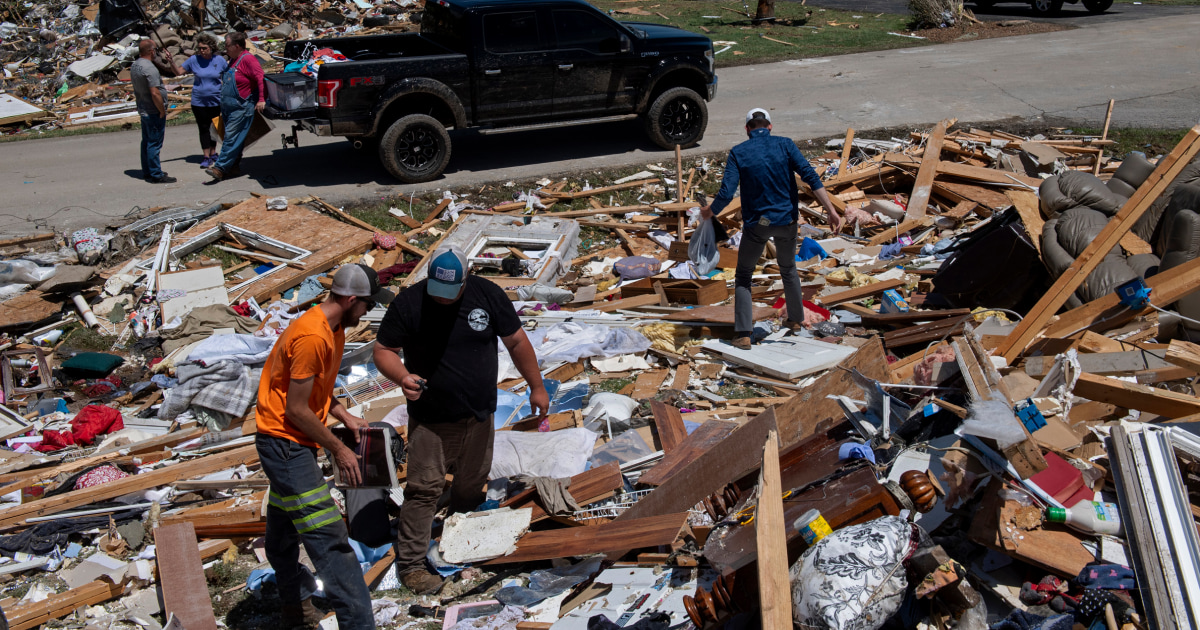Tornadoes and Thunderstorms Claim Lives: A Devastating Storm Hits Kentucky and Missouri
A deadly storm system tore through Kentucky and Missouri overnight, leaving at least 25 people dead and a trail of destruction in its wake. The violent tornadoes and thunderstorms struck late Friday into early Saturday, leveling homes, uprooting trees, and cutting power to thousands. Emergency responders are scrambling to assist survivors as officials warn the death toll may rise amid ongoing search-and-rescue efforts.
Widespread Destruction and Immediate Response
The hardest-hit areas include western Kentucky and southeastern Missouri, where EF-3 tornadoes—with winds exceeding 136 mph—flattened entire neighborhoods. In Mayfield, Kentucky, a historic courthouse collapsed, and a candle factory was reduced to rubble, trapping workers inside. Missouri’s Pemiscot County reported severe flooding, with highways submerged under feet of water.
“This is one of the most devastating storm events I’ve seen in my 20 years of emergency management,” said Kentucky Governor Andy Beshear in a press conference. “We’ve deployed the National Guard and are working with FEMA to expedite aid.” Meanwhile, Missouri Governor Mike Parson declared a state of emergency, activating disaster relief funds.
- Confirmed fatalities: 25 (18 in Kentucky, 7 in Missouri)
- Injuries: Over 150 hospitalized, dozens in critical condition
- Power outages: 120,000+ customers without electricity
Meteorological Breakdown: Why This Storm Was So Deadly
According to the National Weather Service (NWS), the storm system developed due to an unusually warm air mass colliding with a cold front, creating ideal conditions for long-track tornadoes. One tornado traveled over 200 miles—a rarity for December—with a path width exceeding half a mile in places.
Dr. Samantha Carter, a climatologist at the University of Missouri, noted, “These storms are consistent with climate change trends, where warmer winters fuel more intense and out-of-season severe weather.” Data from the Storm Prediction Center shows December tornadoes in the region have increased by 35% since 2000.
Community Resilience Amid the Chaos
Survivors recount harrowing escapes. “I grabbed my kids and hid in the bathtub as the roof flew off,” said Mayfield resident Lisa Henderson. “When we came out, our street was gone.” Local shelters are overflowing, and organizations like the Red Cross are providing meals and medical care.
Volunteers from neighboring states are assisting with debris removal, while social media campaigns raise funds for displaced families. However, challenges persist: damaged infrastructure hampers supply deliveries, and freezing temperatures threaten those without heat.
Recovery Challenges and Federal Aid
Rebuilding could take years, with early damage estimates surpassing $1 billion. FEMA Administrator Deanne Criswell pledged swift action: “We’re prioritizing temporary housing and low-interest loans for businesses.” Critics, however, argue rural areas may face delays due to bureaucratic hurdles.
Key recovery priorities include:
- Restoring power and clean water access
- Clearing roads for emergency vehicles
- Providing mental health support for trauma survivors
Looking Ahead: Climate Preparedness and Policy
Experts urge lawmakers to strengthen building codes and early-warning systems. “Investing in storm-resistant infrastructure saves lives,” said Carter. Meanwhile, the NWS is testing a new radar system to improve tornado detection lead times beyond the current 13-minute average.
For now, affected residents focus on solidarity. “We’ll rebuild,” said Henderson. “But we need help to do it.” How to assist: Donate to verified relief funds via the Red Cross or local United Way chapters.
See more Your Daily Weather



